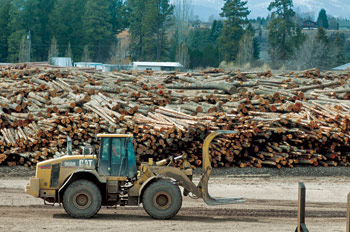If a look and a sound can tell a story, the look on Tom Ray’s face as he listened to the collective sound of a buzzing sawmill told a story that Northwest Montana would like to hear. It’s the story of an industry recovering, or perhaps a chapter in what people like Ray hope will be a much longer story of a proud timber tradition regaining its footing.
Ray, the vice president of Northwest resources and manufacturing for Plum Creek, had reason to smile last week as he walked through his company’s Evergreen stud mill, recently revived after years of dormancy. He toured the facility on March 27, the mill’s first full day of production since it went dark in June 2009. It’s been a tough few years for the timber and forest products industry, but some signs of a rebound are emerging and others have already arrived. The stud mill’s reopening is proof.
Plum Creek officials saw enough evidence in rising housing starts and skyrocketing lumber prices to warrant firing up the shuttered Evergreen mill, which immediately created 30 jobs. The timber company also plans to add a shift – another 15 new employees – at its Columbia Falls medium-density fiberboard plant. And Ray sees evidence that his industry will continue to strengthen throughout the year.
“There definitely is optimism in the industry,” Ray, who oversees Plum Creek’s manufacturing operations and manages its timberland resources in the Northwest, said. “Things are much brighter now.”
Earlier this month, lumber prices hit an eight-year high, largely thanks to vast improvements in U.S. home construction. In February, housing starts nationwide hit a five-year high and the U.S. Department of Commerce has pegged the annual rate of overall starts at 917,000, up from around 500,000 in 2009. New building permits, which indicate future construction, rose in February to 946,000, the highest since June 2008. Plywood prices are also up.
Plum Creek remains a good barometer of the wood products industry’s health, even if it has increasingly branched out into real estate over the years. As the nation’s largest private landowner with 6.4 million acres of land in 19 states, the timber giant has long been a major economic force in Montana, where it owns 900,000 acres – more than in any other state. The Flathead Valley is the center of its Montana operations.
After the housing market crashed in 2008, sawmills and plants around the state and nation shut down, including the Smurfit-Stone Container Corp. in Frenchtown, a closure that sent shockwaves through the timber industry. Others like Stoltze Land and Lumber Company’s sawmill in Columbia Falls survived but were forced to scale down operations and shut down temporarily.
Plum Creek got hit hard too. In Northwest Montana, the company shuttered its Ksanka sawmill in 2009, followed later by its mill operations in Pablo and its mill in Evergreen. The company reported heavy losses and shed hundreds of jobs. It was a bleak time for a longtime pillar of western Montana’s natural resource economy.
Following those darkest days of 2009, it has been a slow crawl back to health for the industry, a crawl that picked up speed last year. Plum Creek reported in January that its fourth-quarter earnings rose nearly 30 percent from $61 million in 2011 to $79 million last year. Revenues and earnings were also up for the entire year.
All of which set the stage for a strong 2013, kicked off by the Evergreen mill’s restarting.
“Over the past year, housing has moved from being a drag on the economy to being a bright spot,” Plum Creek President and CEO Rick Holley said in a February statement announcing the mill restart. “We are seeing improving demand for lumber and wood panels that is expected to translate into higher demand and pricing for logs in 2013.”
 |
|
A log loader navigates past stacks of logs at the Plum Creek Evergreen stud mill. Lido Vizzutti | Flathead Beacon |
Montana’s federal delegation has taken note of the industry’s rebound and made clear they feel timber should continue to play an important role in the state’s economy. Democratic Sen. Jon Tester said last week “reopening the Evergreen mill is an important step towards strengthening our state’s timber industry.”
And Republican Rep. Steve Daines embarked on a statewide natural resources tour last week, making stops at Roseburg Lumber in Missoula, Stoltze Lumber in Columbia Falls, Pyramid Lumber in Seeley Lake and Plum Creek’s medium-density fiberboard (MDF) plant in Columbia Falls.
Based on his conversations at those facilities, the congressman said there’s widespread concern in the industry about the difficulties of harvesting timber on federal lands, but he also noted that he received a lot of optimistic feedback as well.
“The best thing I’ve heard today is, ‘We’re hiring again,’” Daines said.
On March 28, Daines toured Plum Creek’s sprawling MDF plant, which, when operating at full production, is the largest of its kind in North America. It features 7.5 acres under its roof, with both a thick and thin board line. With the addition of 15 new employees, anticipated this month, the plant will employ 170 people. Plum Creek added 60 employees last year at its various Montana facilities.
Jerry Sorensen, senior director of land asset management for Plum Creek’s northern division, said his company has 750 employees in Montana with an average wage of $20 per hour. Last year, Plum Creek paid $50 million in direct payroll and another $80 million to logging contractors, haulers and other service providers.
At the beginning of Daines’ tour of the MDF facility, the plant’s product line manager, Bob Hickey, described the company’s job growth with an exuberance that rivaled Ray’s from the day before.
“It’s good for us and it’s good for the community,” Hickey said. “It’s really exciting.”